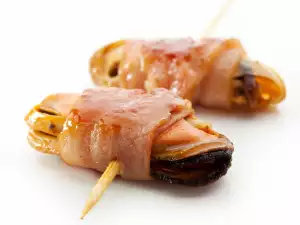Saffron Milkcap /Lactarius deliciosus/ is a delicious and highly honored mushroom. The cap is initially flat with a semi-folded edge, but later it spreads and it is funnel-shaped and concave in the middle.
The cap reaches 5 to 15 cm in diameter and its color is carrot-orange to brick-red with dark and concentric circles, which become greenish when the mushroom ages.
The surface of the saffron milkcap is bare and smooth, moist and often sticky. Greenish spots appear when injured. The gills of the mushroom are densely arranged, descending and firmly attached to the stump. The lamellae are orange in color and also turn green when injured.
The stump of the saffron milkcap is cylindrical and reaches a height of 3 to 9 cm. It is more pale orange than the cap, hollow and fragile.
Initially it is hollow, but later the cavities appear. When cut with a knife, it releases red juice and later the injured area, like the rest of the mushroom, turns green.
The flesh of the saffron milkcap is tender and porous, bright orange and colored with milky liquid. It has a pleasant taste and mild mushroom aroma. When injured, it turns green and when left for about 10-20 minutes it acquires a dark cherry red color.

Picking and storaging saffron milkcap
The saffron milkcap grows from May to November, usually closing the mushroom season. In October-November, when the growth ends, the harvest is richest, especially during periods of clear sunny days, when the first frosts are melting. It is found in close proximity to young coniferous forests and in rare cases inside them.
Saffron milkcap should be picked with great care, because it has a poisonous look alike. This is poisonous milkcap or horse mushroom. The two mushrooms differ in the following features:
When cutting or breaking off parts of the stump of the edible saffron milkcap, an orange juice is always released, which cannot be missed at all, because it stains the hands or the knife. Poisonous milkcap releases white juice.
Another important difference is that when the stump or cap of the saffron milkcap is injured, greenish-bluish spots appear for a short time. Similar spots can be observed in old milkcap mushrooms without being injured. Poisonous milkcap lacks such coloration.
A third significant difference is that the cap of the poisonous milkcap is covered with moss and at its very edge there are gills wrapped inwards. These things are completely absent in the edible saffron milkcap.

Cooking saffron milkcap
Saffron milkcap has very good taste and a pleasant aroma of fruit. It is suitable for consumption in soups and meat dishes, can be fried and stewed. Saffron milkcap can be sterilized in jars, frozen in the freezer, but after blanching.
This is one of the most suitable mushrooms for pickles without heat treatment. It is necessary to pour a cold boiled solution of water, vinegar, salt, sugar and various spices / garlic, bay leaf and black pepper.
Saffron milkcap is not suitable for drying, because it loses its specific aroma and taste. In some European countries, such as Russia and Northern Germany, the mushroom is consumed after a special treatment - boiling in cold water.
Harms from saffron milkcap
Saffron milkcap, like other types of mushrooms, is a difficult-to-digest food and can cause stomach discomfort in people with more delicate stomachs. Therefore, its consumption for dinner is not recommended.
Sometimes intolerance is expressed like nausea, stomach pain, vomiting, discomfort. If dangerous symptoms occur after consuming saffron milkcap, seek immediate medical attention, as this may be poisoning.
As it turned out, saffron milkcap has a very dangerous poisonous look alike, so picking this mushroom requires special attention.




















Comments